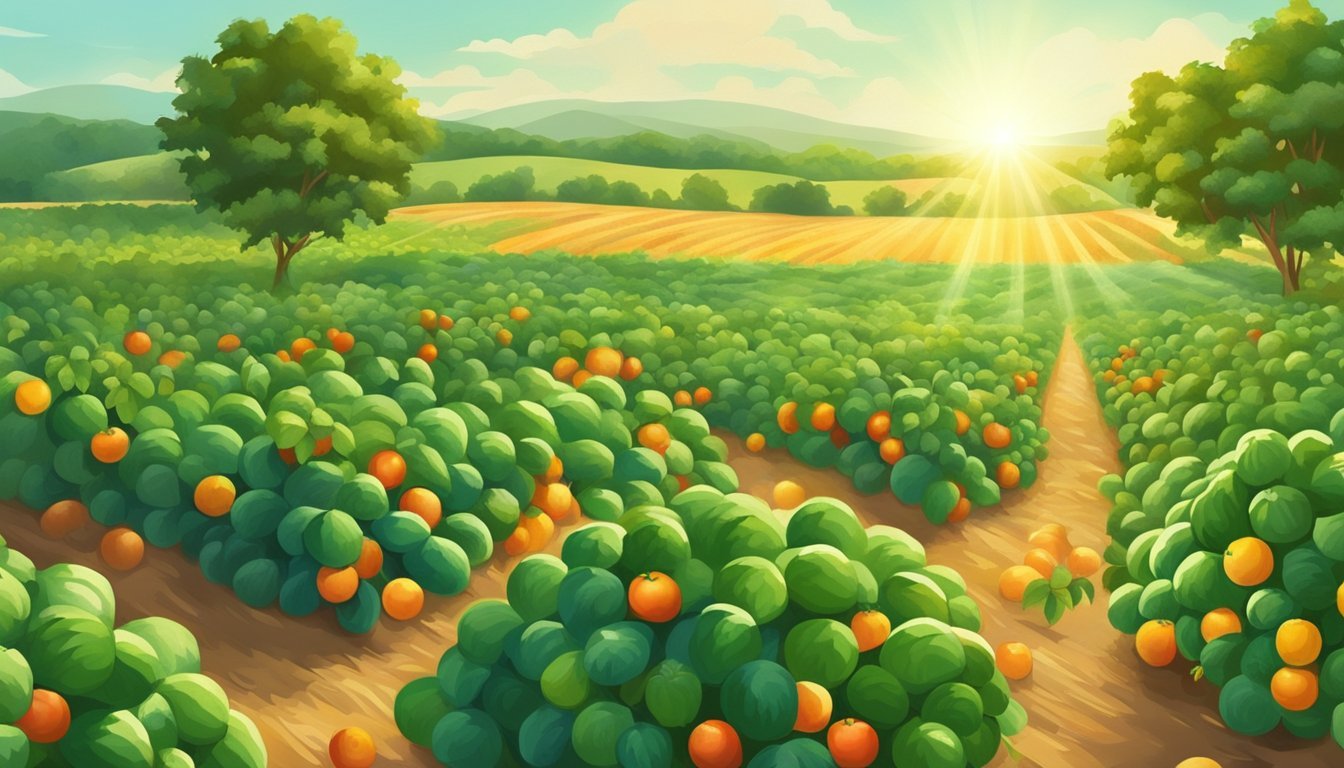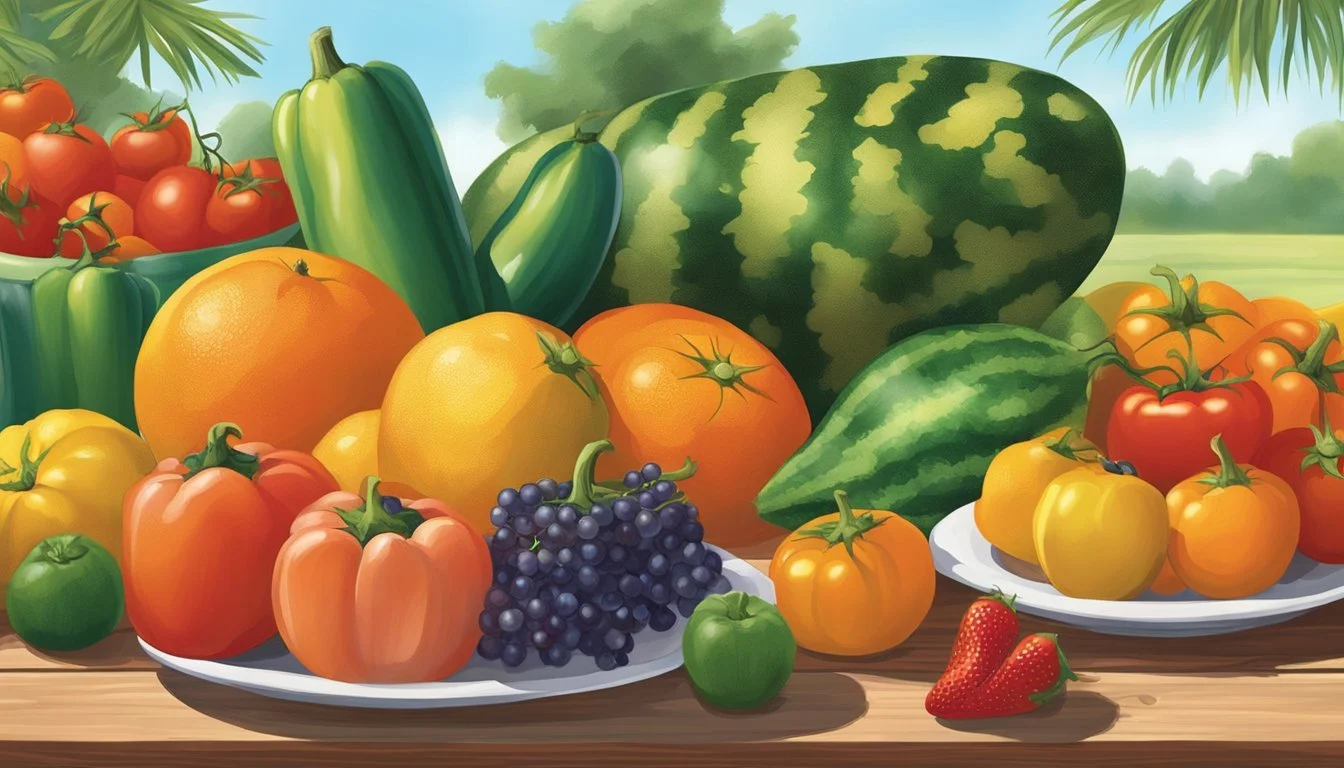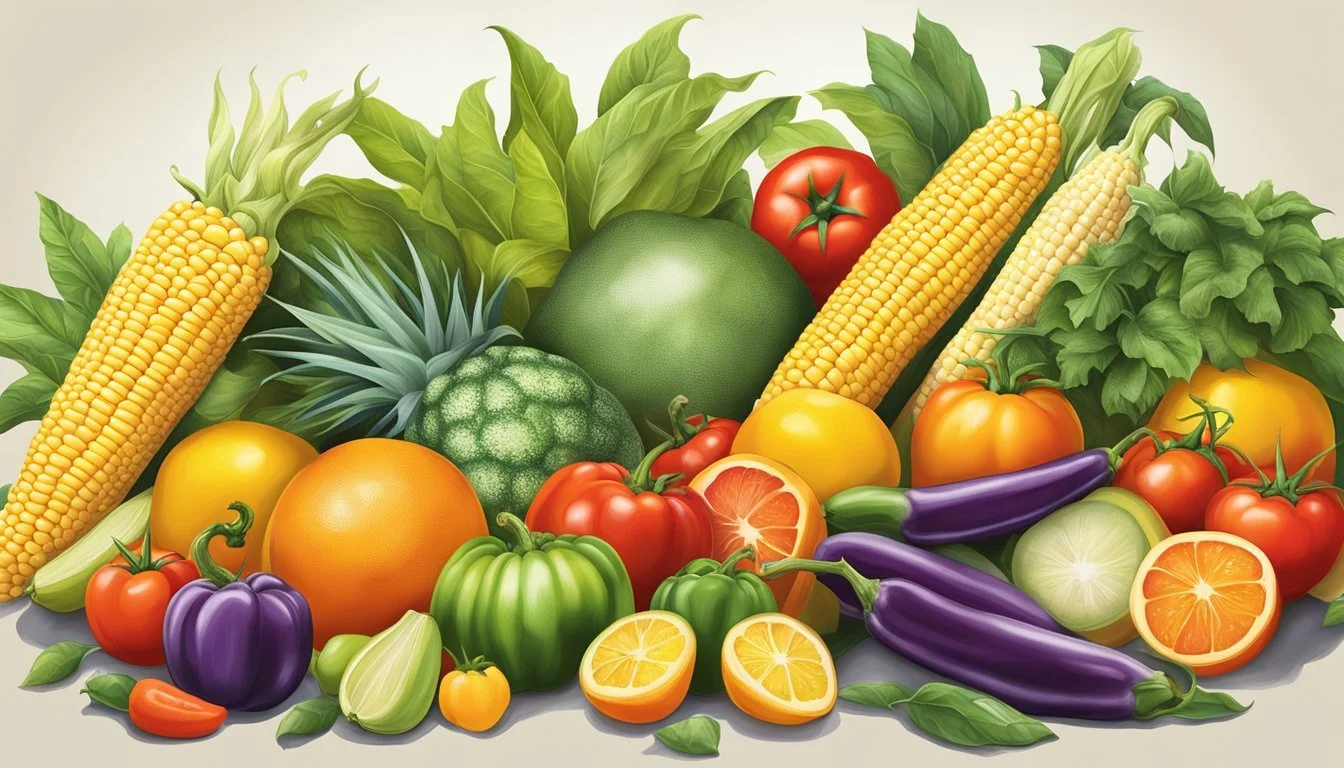Florida Seasonal Fruit & Vegetables in August
Your Fresh Guide
This Article is Part of our Florida Seasonal Fruit & Veg Calendar
In the height of summer, Florida’s agricultural abundance is in full swing. August’s warm weather and frequent rain showers create a lush backdrop for a variety of fruits and vegetables to thrive. For locals and visitors alike, this month offers the opportunity to experience the peak flavors of some of Florida's most beloved produce. Markets and roadside stands are brimming with fresh picks, reflecting the state's rich farming heritage.
Florida is renowned for its citrus, but August marks a timeframe when citrus fruits are generally out of season. Instead, the focus shifts towards other fruits like bananas which become ripe under the Florida sun during this period. Vegetables such as okra and southern peas also flourish now, offering fresh, earthy flavors ideal for light summer meals.
The diversity of Florida’s crops during August provides a picnic basket of opportunities for farm-to-table experiences. Enthusiasts of fresh produce can weave seasonal fruits and vegetables into their cooking, enjoying the crisp, natural tastes that define the Floridian summer palate. Chefs and home cooks alike take pride in crafting dishes that honor the local produce available during this month.
Understanding Florida's Growing Seasons
Florida's climate offers a unique growing environment that supports a variety of fruits and vegetables year-round, with fluctuations mostly defined by the seasonal changes. Summer in Florida spans from June through September, characterized by high temperatures and humidity which can be challenging for many crops.
Fall, occurring from October to December, marks a transition period with reduced humidity and cooler temperatures, making it ideal for planting a diversity of produce. During this time, growers often start sowing seeds for the winter harvest.
Winter in Florida, between December and February, is mild compared to northern regions. This season is prime for growing cool-weather crops, as the risk of frost is lower, especially in Central and South Florida.
When spring arrives in March, it ushers in a warm growing season again, lasting until May. Spring is notable for the resurgence of warmth and the beginning of what might be considered the main growing cycle for numerous fruits and even more vegetable varieties.
Below is a brief overview highlighting seasonal crop tendencies:
Season Typical Crops Summer: Heat-tolerant vegetables like sweet potatoes and tropical fruits Fall: Leafy greens, root vegetables, and citrus fruits start Winter: Cool-weather crops such as strawberries and broccoli thrive Spring: Tomatoes, peppers, and watermelons begin to be planted
Growers must be aware of the seasonal variations to optimize their harvests. The understanding of Florida's growing seasons is crucial for gardeners and farmers to select appropriate crops and planting schedules.
Summer Fruits and Vegetables
August in Florida is a month teeming with an abundance of lush fruits and vibrant vegetables. It is a prime time for tropical delights and hearty greens that thrive in the warm Sun State climate.
Tropical Fruits in Season
In August, the tropical fruit palette of Florida is particularly rich. Mangoes hang heavy on the trees, ripe and ready for consumption, offering a juicy, sweet treat amidst the summer heat. Not far behind in popularity are guava and passion fruit, both of which boast an aromatic presence and a burst of flavor that is synonymous with the season.
Mango: Available
Guava: In season
Passion Fruit: Ready for harvest
Another summer specialty, watermelon is ubiquitous during this time, its refreshing quality making it a staple for beach trips and picnics. While blueberries are nearing the end of their season, they can still be found fresh in the early parts of the month.
Summer Harvest Vegetables
The vegetable harvest in August is equally impressive. Florida's summer soil yields a variety of melons beyond watermelon, including cantaloupe and honeydew, which are at their peak sweetness. These melons provide essential hydration and nutrients during the hotter days.
Vegetables in Peak Season:
Cantaloupe: Sweet and ripe
Honeydew: Optimal flavor
While temperatures rise, sturdy greens like collard greens manage to thrive, their leaves offering a nutritious option for salads and cooked dishes. Farm stands and markets proudly display these summer vegetables, signifying their fresh and local origin.
August's Harvest: What to Expect
In Florida, August is a month of abundance in both fruit and vegetable varieties. With the state's warm climate, many crops reach peak ripeness, offering consumers a rich selection of fresh produce.
Fruit Highlights
Avocados: These creamy fruits are a staple of Florida's August produce. Grown primarily in the southern regions of the state, avocados are known for their versatility and health benefits.
Mangoes: They capture the essence of a Florida summer. These tropical treasures are at their juiciest and most flavorful during the month.
Carambola (Starfruit): Easily recognized by their unique shape, carambolas provide a crisp, tart flavor that's perfect for a hot August day.
Grapes: Florida's grape varietals, including the popular Muscadine, flourish in the late summer sun, making it a prime time for both table grapes and local winemaking.
Guava: This aromatic fruit, rich in vitamin C, turns kitchens into tropical havens with its sweet and slightly tangy taste.
Vegetable Highlights
Eggplant (What wine goes well with eggplant?): Thick-skinned and purple-hued, eggplants harvested in Florida are ideal for a range of dishes, from hearty stews to grilled selections.
Tomatoes: A key ingredient in many cuisines, tomatoes harvested in August in Florida are known for their deep red color and robust flavor.
Peppers: From sweet bells to spicy jalapeños, peppers add a pop of color and flavor to Florida's summer harvest.
Potatoes: Often overshadowed by the state's fruit, Florida's potatoes come into season in August, bringing a variety of shapes, sizes, and colors to local markets.
Health Benefits and Nutrition
August in Florida offers a bounty of fresh produce that is not only rich in flavor but also packed with nutritional benefits.
Vitamin-Rich Produce
Oranges: A staple in Florida's August produce, oranges are a powerhouse of Vitamin C. This essential nutrient is crucial for the maintenance of healthy skin and the immune system. Consuming oranges can provide a substantial amount of the daily recommended intake of Vitamin C.
Kale: Also abundant during this month, kale is a nutritious leafy green high in vitamins A, K, and C. It is an excellent source of minerals and fiber, supporting overall health and aiding in digestion.
Antioxidants in Seasonal Fruits and Veggies
Antioxidant-rich foods play a significant role in neutralizing free radicals in the body, which can help in reducing inflammation and preventing chronic diseases.
Radishes: Available during August, radishes not only add a peppery crunch to dishes but also come loaded with antioxidants and minerals.
Oranges: Besides their high Vitamin C content, oranges contain a variety of antioxidant compounds that help fight oxidative stress.
The seasonal fruits and vegetables harvested in August in Florida like oranges and kale, provide a combination of vitamins, minerals, and antioxidants that contribute to better health and nutrition.
Recipes and Preparation Ideas
August in Florida brings a bounty of seasonal fruits and vegetables ideal for a variety of recipes. From summer salads bursting with freshness to chilled beverages, and not forgetting sweet, fruity desserts, the use of seasonal produce can elevate both taste and nutritional value.
Summer Salads and Sides
One can showcase seasonal produce like corn, cucumbers (how long do cucumbers last?), and eggplant in vibrant salads. A Corn and Cucumber Salad with Fresh Herbs perfectly pairs the sweetness of corn with the crispness of the cucumber. For a heartier side dish, Roasted Eggplant with a Balsamic Glaze emphasizes the vegetable's rich texture, making it a consistent favorite.
Corn and Cucumber Salad
Fresh corn, shucked and kernels removed
Cucumbers, thinly sliced
A variety of fresh herbs (e.g., basil, parsley)
Simple vinaigrette
Roasted Eggplant
Sliced eggplant, seasoned with salt and olive oil
Roasted until tender
Drizzled with balsamic glaze before serving
Refreshing Beverages and Smoothies
Dragon fruit and coconuts, harvested in this period, can be blended into Refreshing Dragon Fruit Smoothies or used to create Coconut Water Refreshers. These drinks not only quench thirst but also provide a hydrating reprieve from the summer heat.
Dragon Fruit Smoothie
Dragon fruit pulp
Banana for creaminess
A splash of coconut water or apple juice
Coconut Water Refresher
Chilled coconut water
Slices of cucumber or citrus fruits
Mint leaves for an aromatic touch
Creative Desserts
Finally, when it comes to desserts, one can utilize chiles for a surprising kick in a Chocolate-Chili Sorbet or combine stone fruits like peaches and mangoes in a Summer Fruit Compote that can be served with ice cream or as a tart filling.
Chocolate-Chili Sorbet
Dark chocolate, melted with a hint of chili powder
Churned with a simple sugar syrup
Summer Fruit Compote
Mixed stone fruits (peaches, mangoes), simmered with sugar until soft
Can be flavored with vanilla or citrus zest
Incorporating these seasonal ingredients into recipes provides a unique opportunity to savor the flavors of Florida's August produce while getting creative in the kitchen.
Buying and Storing Tips
When purchasing fruits and vegetables in Florida during August, one should select produce that feels heavy for its size, indicating freshness and juiciness. Vendors at local farmer's markets often provide the freshest options, directly from the farm to the consumer.
Fruits like bananas and blueberries should have vibrant colors and no signs of bruising. Once home:
Bananas: Store at room temperature and separate from other produce to avoid accelerated ripening.
Blueberries: Refrigerate in a breathable container and rinse just before eating.
Vegetables in season, such as tomatoes:
Tomatoes: Keep at room temperature away from sunlight, as refrigeration can reduce flavor and cause a mealy texture.
Grocery stores' consumer services might offer additional storage tips for specific produce. It's always a good idea to ask if uncertain.
For proper storage, one should use breathable mesh bags instead of plastic to prevent moisture buildup, which can lead to premature spoilage. If freezing is an option for the long-term, ensure fruits and vegetables are appropriately prepared for freezing to maintain texture and flavor upon use.
To ensure optimal freshness, consume most produce within a few days of purchase. In the case of fruits that might ripen quickly, such as bananas, one can store them in the refrigerator once they've reached the desired ripeness to prolong their shelf life.
Always remember to wash fruits and vegetables thoroughly before consumption, even if they will be peeled, to remove any pesticides or contaminants that might be present on their surface.
Local Farming and Production
August marks a transition period within Florida's agricultural landscape, where farming operations and markets adjust their focus towards the crops best suited for the end of summer.
Florida Farmers and Markets
Florida farmers play a pivotal role in maintaining the availability of fresh produce throughout the year. During August, these agricultural experts pivot to harvesting crops that thrive in the state's warm, humid climate. Markets across Florida work closely with local farms to supply consumers with a variety of fresh fruits and vegetables. Popular crops such as mangoes, avocados, and guava are typically available at this time, demonstrating an alignment with the seasonal produce calendar.
Key August Crops in Florida:
Mangoes
Avocados
Guava
Sustainable Agriculture Practices
Farmers in Florida are known for their sustainable agriculture practices. These methods ensure the long-term viability of the state's farmland and contribute to eco-friendly production processes. Tactics such as crop rotation, the use of organic fertilizers, and water conservation techniques are utilized. The Florida Department of Agriculture and Consumer Services often supports these initiatives, recognizing their importance in promoting sustainability within the state's agriculture industry. This department provides resources and guidelines to help local farmers implement such environmentally responsible practices.
Sustainable Practices Include:
Crop rotation to prevent soil depletion
Usage of organic fertilizers to reduce chemical input
Water conservation methods to ensure resource sustainability
Contacting the Florida Department of Agriculture
Consumers seeking information about Florida’s seasonal produce can reach out to the Florida Department of Agriculture & Consumer Services. This state department is a valuable resource for both consumers and agricultural businesses, providing guidance on various topics including seasonal availability of fruits and vegetables.
Those interested can contact the department in several ways:
Phone: For immediate assistance or inquiries, individuals may call the main helpline.
Email: Queries can be sent via email, often useful for less urgent matters or to obtain specific documentation or resources.
Website: The department’s official website houses a wealth of information and provides contact forms for electronic communication.
Social Media: For current updates and quick interactions, their social media platforms can be a convenient point of contact.
Below is contact information for quick reference:
Method Detail Phone [Provided phone number] Email [Provided email address] Website [URL to the Florida Department of Agriculture & Consumer Services] Social Media Links to official social media pages
The Florida Department of Agriculture & Consumer Services encourages individuals to explore their resources, including the Florida Seasonal Availability Chart, which is an excellent tool for identifying what produce is in season each month, including August.







